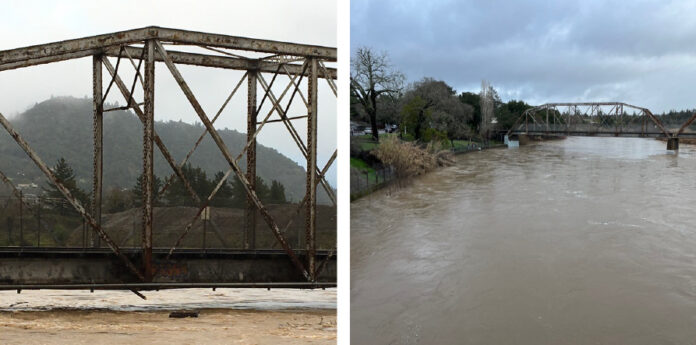
In February 2019, Healdsburg got 20.8 inches of rain in 48 hours, causing flooding of the Russian River, shown in the left picture.
Flood waters crested just below the decking of the old railway bridge. It was the worst flooding in 24 years, cresting at 46 feet. The highest flood stage for the Russian River was almost 50 feet in 1986. Both recent floods. Flood levels for this week’s storm (at the time of this writing) are predicted to rise; however, the right picture shows cresting waters are still below the white portion of the concrete abutments.
Snowpack in Tahoe’s Sierras is building up. Snows at Lassen and Shasta are building up, with reports of eight feet falling in the last couple of days. So, let’s hope the rain doesn’t “go away,” but remains gentle over time to fill California’s reservoirs and groundwater reserves without undue flooding of the Russian River and its nearby towns and cities.
Here’s a record of historical flooding on the Russian River, reported in order of magnitude, highest to lowest: 48.8’ in 1986, 48.0’ in 1995, 47.6’ in 1955, 47.4’ in 1964, 46.9’ in 1940, 45.4’ in 2019, 45.0’ in 1997, 42.5’ in 1966, 42.1’ in 1879, 41.8’ in 2006, 41.5’ in 1995, 41.3’ in 1970, 41.1’ in 1963, 40.7’ in 1974, 40.4’ in 1983 and 40.2’ in 1958.
Fun facts: “Rain Rain Go Away” is a nursery rhyme published in 17th century England. It is also a song recorded by Bobby Vinton, released in 1962. Isaac Asimov wrote a short story, “Rain, Rain Go Away,” published in 1959. It’s a fantasy horror story about a family who avoids rain at all costs, lest they dissolve like sugar confections; in the end, they do.
The Beatles’ song, “Rain,” was released in June 1966 as the B-side of “Paperback Writer,” included in the Revolver album. “Rain” lyrics include this opening line: “If the rain comes, they run and hide their heads. They might as well be dead, if the rain comes,” harkening back to Asimov’s story. “Rain” was also the first song to feature a recording tape played backwards intentionally—a technique known as “backmasking.”







